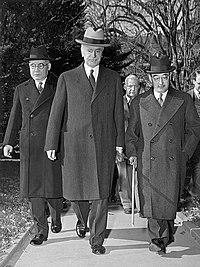Kichisaburō Nomura
Kichisaburō Nomura | |
|---|---|
Shinjuku, Tokyo, Japan | |
| Allegiance | |
| Service/ | |
| Years of service | 1898–1937 |
| Rank | |
| Commands held |
|
| Awards | Order of the Rising Sun |
| Other work |
|
| Signature | |
Kichisaburō Nomura (野村 吉三郎, Nomura Kichisaburō, December 16, 1877 – May 8, 1964) was an admiral in the Imperial Japanese Navy and was the ambassador to the United States at the time of the attack on Pearl Harbor.
Early life and career
Nomura was born in
Promoted to lieutenant on September 26, 1903, he served on a large number of ships, including the gunboat Maya, corvette
On Nomura's return to Japan, he received his first command, the cruiser
Admiral

On June 1, 1922, Nomura was promoted to
During the
A few months later in April 1932, a
Nomura was promoted to full admiral on March 1, 1933. From 1933 to 1937, Nomura served as Naval Councilor on the Supreme War Council, and retired from active service in 1937.
Diplomat

After his retirement, Nomura was principal of the Gakushūin Peer's school from 1937 to 1939. He was appointed Foreign Minister of Japan from 1939 to 1940 in the cabinet of Nobuyuki Abe.
On November 27, 1940, Nomura was sent as ambassador to the United States, replacing Kensuke Horinouchi, who had served since March 1939. Roosevelt, who as Assistant Secretary of the Navy knew Nomura back in his Washington DC years, welcomed the appointment of the fellow Navy man whom he liked as an honest man. Throughout much of 1941, Nomura negotiated with United States Secretary of State Cordell Hull to prevent the war between Japan and the United States. Nomura attempted to resolve issues including the Japanese conflict with China, the Japanese occupation of French Indochina, and the US oil embargo against Japan. Nomura's repeated pleas to his superiors to offer the Americans meaningful concessions were rejected by his government, while Hull and his boss Roosevelt were far from yielding themselves.[4] On November 15, 1941, Nomura was joined by a "special envoy" to Washington, Saburō Kurusu.[5]
The retired Admiral, and in fact the entire Japanese Foreign Office, was kept in the dark as to the Japanese Navy's impending attack upon Pearl Harbor.[6] Nomura and Kurusu had to decode the radioed message of Japan's breaking off of the negotiations with the United States, which practically meant war. It was sent from Japan on Monday, December 8, Japan time, and received while the Washington embassy's technical support staff were still on their Sunday off. Nomura stated that was why he was unable to deliver the message until after the actual attack had taken place.[7]
In his memoirs, Hull credited Nomura for trying sincerely to prevent the war. While the Japanese Consulate struggled to decipher their own code, Washington had broken it and Hull knew how Nomura was being used by Tokyo as a convenient time-buying ploy. All in vain, but Nomura, who understood America and respected it, always hoped for the breakthrough for peace and believed it was possible.[8]
Later life
On August 20, 1942, Nomura returned to Japan. He continued to serve in an unofficial capacity as an advisor to the government through World War II, and he was appointed to the
After the war, the well-connected and well-liked Nomura started new careers. He was frequently visited and supported by the members of American Council on Japan including the former US Ambassador to Tokyo, Joseph Grew, who were convinced that their amiable old friend still had an important role to play in newly democratic Japan and the new US-Japan relationship. He was invited by Prime Minister Shigeru Yoshida, close ally of GHQ, the US Forces in Japan, and of the American Council, to serve as a committee member studying the rearmament of Japan during the Cold War.
In 1954, Nomura ran for the
Nomura was re-elected to the upper house in 1960 and died in office in 1964.[10]
Honors
From the corresponding article in the Japanese Wikipedia[unreliable source]
- Grand Cordon of the Order of the Rising Sun – 7 February 1934
- Order of the Golden Kite, Second Class – 29 April 1934
- Grand Cordon of the Order of the Sacred Treasure – 13 July 1940
- Grand Cordon of the Order of the Paulownia Flowers – 8 May 1964 (posthumous)
- Navy Distinguished Service Medal– 1918 (United States)
Citations
- ^ "Nomura, Kichisaburo". Nishida. Retrieved February 25, 2020.
- ^ Morris-Suzuki et al. 2013, p. 169.
- ^ Polmar & Allen 2012, p. 584.
- ^ Herbert P. Bix, Hirohito and the Making of Modern Japan, p. 421
- ^ Prange 1981, p. 358.
- ^ Victor 2007.
- ^ Stinnett 2000.
- ^ Hull, Cordell (1948). The Memoirs of Cordell Hull, Part II. New York: Macmillan Company. p. 987.
- .
- ^ "NOMURA, 86, DIES; JAPANESE ENVOY; Admiral Was Negotiating With Hull on Dec. 7, 1941". The New York Times. May 8, 1964. Retrieved May 23, 2023.
General references
Books
- Morris-Suzuki, Tessa; Low, Morris; Petrov, Leonid; Tsu, Timothy Y. (2013). East Asia Beyond the History Wars: Confronting the Ghosts of Violence. ISBN 9781136192265.
- Polmar, Norman; Allen, Thomas B. (2012). World War II: the Encyclopedia of the War Years, 1941-1945. Courier Corporation. ISBN 9780486479620.
- ISBN 0-07-050669-8.
- Stinnett, Robert (2000). Day Of Deceit: The Truth About FDR and Pearl Harbor. Free Press (Touchstone edition). ISBN 0-7432-0129-9.
- Victor, George (2007). The Pearl Harbor Myth: Rethinking the Unthinkable. Potomac Books. ISBN 978-1-59797-042-6.
Further reading
- Peter, Mauch (2011). Sailor Diplomat: Nomura Kichisaburo and the Japanese-American War. Harvard University Asian Center. ISBN 978-0-674-05599-5.


